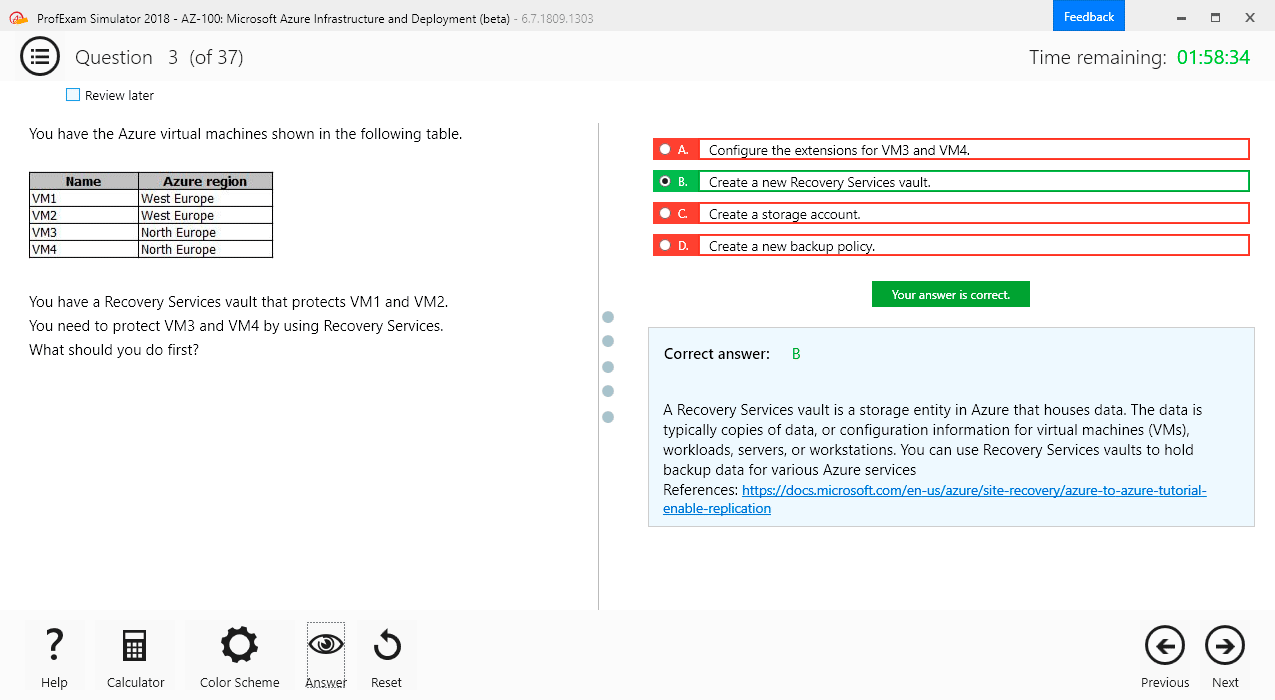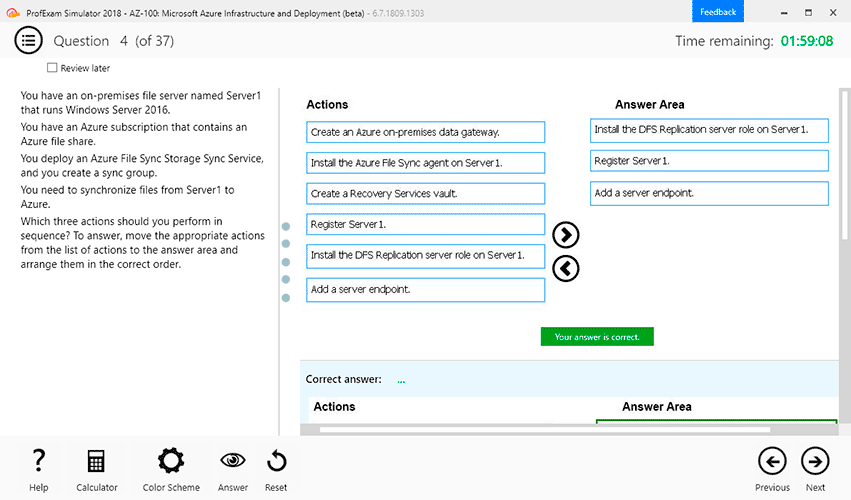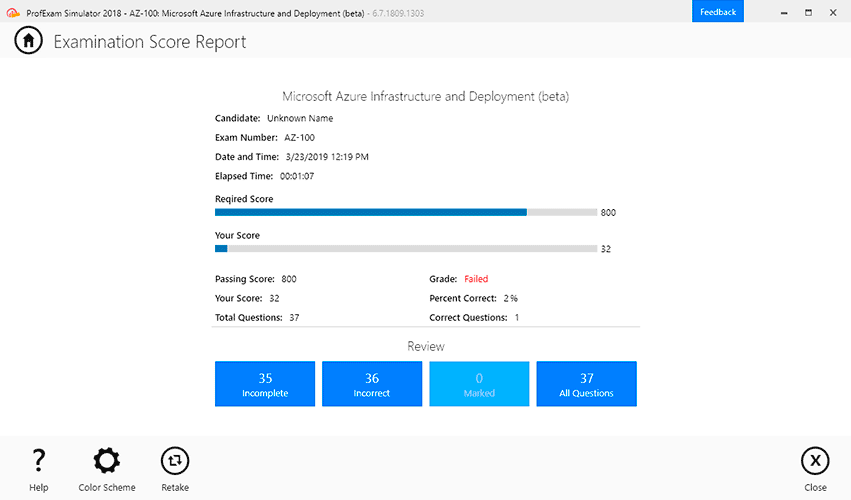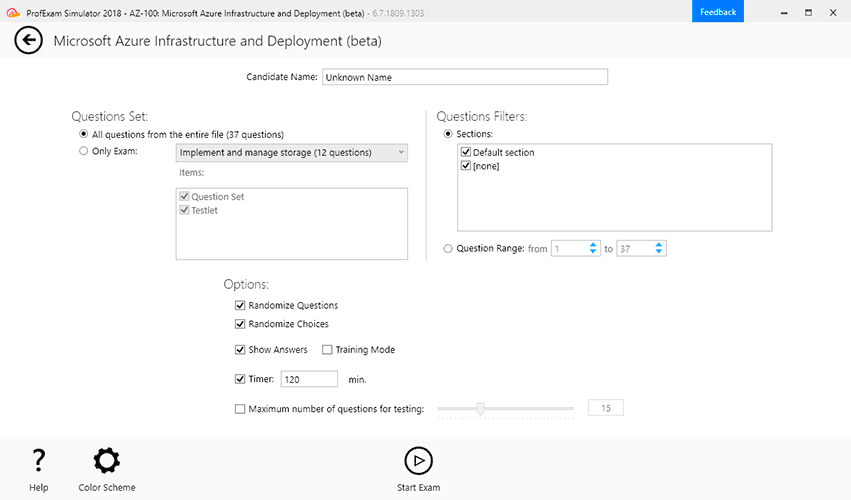File Info
| Exam | Professional Cloud Architect on Google Cloud Platform |
| Number | Professional-Cloud-Architect |
| File Name | Google.Professional-Cloud-Architect.Dump4Pass.2024-11-17.214q.tqb |
| Size | 2 MB |
| Posted | Nov 17, 2024 |
| Download | Google.Professional-Cloud-Architect.Dump4Pass.2024-11-17.214q.tqb |
How to open VCEX & EXAM Files?
Files with VCEX & EXAM extensions can be opened by ProfExam Simulator.
Coupon: MASTEREXAM
With discount: 20%






Demo Questions
Question 1
JencoMart has built a version of their application on Google Cloud Platform that serves traffic to Asia. You want to measure success against their business and technical goals.
Which metrics should you track?
- Error rates for requests from Asia
- Latency difference between US and Asia
- Total visits, error rates, and latency from Asia
- Total visits and average latency for users from Asia
- The number of character sets present in the database
Correct answer: D
Explanation:
From scenario: Business Requirements include: Expand services into Asia Technical Requirements include: Decrease latency in Asia From scenario:
Business Requirements include: Expand services into Asia
Technical Requirements include: Decrease latency in Asia
Question 2
JencoMart wants to move their User Profiles database to Google Cloud Platform.
Which Google Database should they use?
- Cloud Spanner
- Google BigQuery
- Google Cloud SQL
- Google Cloud Datastore
Correct answer: D
Explanation:
Common workloads for Google Cloud Datastore: User profiles Product catalogs Game state Reference: https://cloud.google.com/storage-options/ https://cloud.google.com/datastore/docs/concepts/overview Common workloads for Google Cloud Datastore:
- User profiles
- Product catalogs
- Game state
Reference: https://cloud.google.com/storage-options/
https://cloud.google.com/datastore/docs/concepts/overview
Question 3
You need to optimize batch file transfers into Cloud Storage for Mountkirk Games’ new Google Cloud solution.
The batch files contain game statistics that need to be staged in Cloud Storage and be processed by an extract transform load (ETL) tool. What should you do?
- Use gsutil to batch move files in sequence.
- Use gsutil to batch copy the files in parallel.
- Use gsutil to extract the files as the first part of ETL.
- Use gsutil to load the files as the last part of ETL.
Correct answer: B
Explanation:
Reference: https://cloud.google.com/storage/docs/gsutil/commands/cp Reference: https://cloud.google.com/storage/docs/gsutil/commands/cp
Question 4
You are implementing Firestore for Mountkirk Games. Mountkirk Games wants to give a new game programmatic access to a legacy game's Firestore database. Access should be as restricted as possible. What should you do?
- Create a service account (SA) in the legacy game’s Google Cloud project, add a second SA in the new game’s IAM page, and then give the Organization Admin role to both SAs.
- Create a service account (SA) in the legacy game’s Google Cloud project, give the SA the Organization Admin role, and then give it the Firebase Admin role in both projects.
- Create a service account (SA) in the legacy game’s Google Cloud project, add this SA in the new game’s IAM page, and then give it the Firebase Admin role in both projects.
- Create a service account (SA) in the legacy game’s Google Cloud project, give it the Firebase Admin role, and then migrate the new game to the legacy game’s project.
Correct answer: D
Question 5
Mountkirk Games wants to limit the physical location of resources to their operating Google Cloud regions.
What should you do?
- Configure an organizational policy which constrains where resources can be deployed.
- Configure IAM conditions to limit what resources can be configured.
- Configure the quotas for resources in the regions not being used to 0.
- Configure a custom alert in Cloud Monitoring so you can disable resources as they are created in other regions.
Correct answer: A
Question 6
Your development team has created a mobile game app. You want to test the new mobile app on Android and iOS devices with a variety of configurations. You need to ensure that testing is efficient and cost-effective.
What should you do?
- Upload your mobile app to the Firebase Test Lab, and test the mobile app on Android and iOS devices.
- Create Android and iOS VMs on Google Cloud, install the mobile app on the VMs, and test the mobile app.
- Create Android and iOS containers on Google Kubernetes Engine (GKE), install the mobile app on the containers, and test the mobile app.
- Upload your mobile app with different configurations to Firebase Hosting and test each configuration.
Correct answer: A
Question 7

TerramEarth’s CTO wants to use the raw data from connected vehicles to help identify approximately when a vehicle in the field will have a catastrophic failure. You want to allow analysts to centrally query the vehicle data.
Which architecture should you recommend?
Correct answer: A
Explanation:
The push endpoint can be a load balancer. A container cluster can be used. Cloud Pub/Sub for Stream Analytics Reference: https://cloud.google.com/pubsub/ https://cloud.google.com/solutions/iot/ https://cloud.google.com/solutions/designing-connected-vehicle-platform https://cloud.google.com/solutions/designing-connected-vehicle-platform#data_ingestion http://www.eweek.com/big-data-and-analytics/google-touts-value-of-cloud-iot-core-for-analyzing-connected-car-data https://cloud.google.com/solutions/iot/ The push endpoint can be a load balancer.
A container cluster can be used.
Cloud Pub/Sub for Stream Analytics

Reference: https://cloud.google.com/pubsub/
https://cloud.google.com/solutions/iot/
https://cloud.google.com/solutions/designing-connected-vehicle-platform
https://cloud.google.com/solutions/designing-connected-vehicle-platform#data_ingestion
http://www.eweek.com/big-data-and-analytics/google-touts-value-of-cloud-iot-core-for-analyzing-connected-car-data
https://cloud.google.com/solutions/iot/
Question 8
The TerramEarth development team wants to create an API to meet the company’s business requirements.
You want the development team to focus their development effort on business value versus creating a custom framework.
Which method should they use?
- Use Google App Engine with Google Cloud Endpoints. Focus on an API for dealers and partners
- Use Google App Engine with a JAX-RS Jersey Java-based framework. Focus on an API for the public
- Use Google App Engine with the Swagger (Open API Specification) framework. Focus on an API for the public
- Use Google Container Engine with a Django Python container. Focus on an API for the public
- Use Google Container Engine with a Tomcat container with the Swagger (Open API Specification) framework. Focus on an API for dealers and partners
Correct answer: A
Explanation:
Develop, deploy, protect and monitor your APIs with Google Cloud Endpoints. Using an Open API Specification or one of our API frameworks, Cloud Endpoints gives you the tools you need for every phase of API development. From scenario: Business Requirements Decrease unplanned vehicle downtime to less than 1 week, without increasing the cost of carrying surplus inventory Support the dealer network with more data on how their customers use their equipment to better position new products and services Have the ability to partner with different companies – especially with seed and fertilizer suppliers in the fast-growing agricultural business – to create compelling joint offerings for their customers. Reference: https://cloud.google.com/certification/guides/cloud-architect/casestudy-terramearth Develop, deploy, protect and monitor your APIs with Google Cloud Endpoints. Using an Open API Specification or one of our API frameworks, Cloud Endpoints gives you the tools you need for every phase of API development.
From scenario:
Business Requirements
Decrease unplanned vehicle downtime to less than 1 week, without increasing the cost of carrying surplus inventory
Support the dealer network with more data on how their customers use their equipment to better position new products and services
Have the ability to partner with different companies – especially with seed and fertilizer suppliers in the fast-growing agricultural business – to create compelling joint offerings for their customers.
Reference: https://cloud.google.com/certification/guides/cloud-architect/casestudy-terramearth
Question 9
Your development team has created a structured API to retrieve vehicle data. They want to allow third parties to develop tools for dealerships that use this vehicle event data. You want to support delegated authorization against this data.
What should you do?
- Build or leverage an OAuth-compatible access control system
- Build SAML 2.0 SSO compatibility into your authentication system
- Restrict data access based on the source IP address of the partner systems
- Create secondary credentials for each dealer that can be given to the trusted third party
Correct answer: A
Explanation:
Delegate application authorization with OAuth2 Cloud Platform APIs support OAuth 2.0, and scopes provide granular authorization over the methods that are supported. Cloud Platform supports both service-account and user-account OAuth, also called three-legged OAuth. Reference: https://cloud.google.com/docs/enterprise/best-practices-for-enterprise-organizations#delegate_application_authorization_with_oauth2 https://cloud.google.com/appengine/docs/flexible/go/authorizing-apps Delegate application authorization with OAuth2
Cloud Platform APIs support OAuth 2.0, and scopes provide granular authorization over the methods that are supported. Cloud Platform supports both service-account and user-account OAuth, also called three-legged OAuth.
Reference: https://cloud.google.com/docs/enterprise/best-practices-for-enterprise-organizations#delegate_application_authorization_with_oauth2
https://cloud.google.com/appengine/docs/flexible/go/authorizing-apps
Question 10
TerramEarth plans to connect all 20 million vehicles in the field to the cloud. This increases the volume to 20 million 600 byte records a second for 40 TB an hour.
How should you design the data ingestion?
- Vehicles write data directly to GCS
- Vehicles write data directly to Google Cloud Pub/Sub
- Vehicles stream data directly to Google BigQuery
- Vehicles continue to write data using the existing system (FTP)
Correct answer: B





